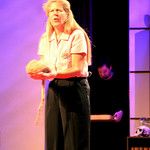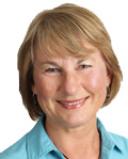Therapy
Creative Rehabilitation, Part 3: Stroke
Gang members and young mothers can have strokes too.
Posted July 12, 2015

Stroke is generally seen as a disorder associated with aging, but some types of stroke can also affect younger people. In fact strokes of any kind can occur even in children. Ischemic strokes, where because of a blockage in a blood vessel feeding the brain, a part of the brain is starved of oxygen and often dies, is the most common form of stroke and most often occurs in people over the age of 60. The opposite type of stroke—where a blood vessel bursts—quite often also occurs in younger people. One form of hemorrhagic stroke is called an intracerebral hematoma, where a clot of blood forms within the brain tissue around a leaking artery. Often as the blood clot rsolves, the patient’s symptoms also resolve,
although the blood clot can result in some permanent brain damage. The other type of bleeding stroke is a subarachnoid hemorrhage (SAH), and this commonly occurs in middle age (around 45 to 60 years) as well as in older people. A weak point on an artery which causes a balloon-like protrusion (an aneurysm) can burst without warning, shooting arterial blood at high pressure around the brain in the subarachnoid space (the space between the fine covering that adheres to the brain surface (the pia mater) and the next layer of covering, the arachnoid mater (named thus because the blood vessels in it look like a spider web; arachnoid being the word for spider). A SAH results in death immediately or in the weeks that follow in almost half of victims, and the remaining patients can suffer very severe brain damage to quite mild brain damage, depending on the force and extent of the bleed. Sometimes these patients also suffer an ischemic stroke as well, because of the stress the subarachnoid blood places on the brain. In patients that survive, the aneurysm is usually clipped off by a neurosurgeon, and the subarachnoid blood is gradually reabsorbed. However, even patients who do well continue to suffer problems with debilitating fatigue, hypersensitivity to noise, and difficulty with concentration and memory (typical symptoms of diffuse brain damage including closed head injury).
Luke, the first case I want to use here as an illustration of how creative rehabilitation can enhance standard rehabilitation, suffered an intracebral hematoma into the left frontal lobe; the area called Broca’s area (because Broca was the neurologist who discovered that this area was related to the ability to speak, called expressive aphasia). Luke was only 28, and had been on a drinking binge when he had his stroke. Hospital was a very uncomfortable place for him for many reasons, but mainly because it was a very white Western institution, and he was Maori, and a gang member. Before his stroke he spent his time riding motorbikes, petty theiving, smoking marijuana and tabbaco, playing snooker (billiards) and consuming large quantities of alcohol. You can read his full case in my book Trouble In Mind, but here I want to focus on some creative aspects of his longer term rehabilitation. Immediately after his stroke Luke couldn’t speak and he had a weak right arm and hand. Ten days later he had recovered some ability to speak in short sentences, and the weakness in his right arm was gradually resolving. He was transferred to a rehabilitation center for further rehabilitation. However he struggled with this, as he felt like a fish out of water surrounded by patients who were mostly white and were definitely not gang members. Prevented from drinking and with the number of cigarettes he was allowed per day limited, he became depressed and apathetic, until one day Sharon, his girlfriend, suggested that she and two of his male gang mates take turns at spending the day at the rehabilitation unit, going to every therapy session with Luke. Their participation in speech and physical therapy not only encouraged Luke, but often added a much-needed humorous touch to the sessions as they would often ‘crack up’ (laugh) at Luke's attempts to talk in sensible sentences, or to perform some physical exercise. This interaction seemed to alleviate Luke's frustration with his slow progress and cause him in turn to ‘crack up’ at his friends' attempts to copy him! He would then gamely try again. The presence of cheerful friends at therapy sessions may well have a negative effect on progress for some people, and the details of a rehabilitation program must be tailored to fit the individual. Luke's mates were there for him between therapy sessions when he wanted to relax; they were sensitive to his moods and knew when to leave him, when to cheer him up, and when to listen to him express his feelings. They became skilled at understanding Luke's body language, and at times were able to relieve him of the weary task of using words to try to communicate important ideas to staff.
Sharon brought in Luke’s guitar, and he would spend thirty minutes or more playing and singing with his friends or by himself, before he became tired. Sometimes the words of songs came spontaneously and sometimes he just hummed, and he had no trouble forming chords with his good left hand. While at first he could only strum with his right hand, he slowly began to pick out blues breaks as his fingers strengthened and his fine finger movements became more coordinated.
Billiards also became a regular feature of Luke's day, at first with a friend helping him push the billiard cue, but gradually gaining the strength and coordination to manipulate the cue himself. His friends even agreed to cut down on their smoking habits to encourage Luke to do likewise. The knowledge that Luke's hemorrhage may have been in part a result of his heavy smoking had been a salutary experience for them.
Luke was discharged to live with his parents three months after his hemorrhage, and continued to attend speech and physical therapy twice a week for a further three months as an outpatient at a hospital closer to his home. Later he shifted into a house with Sharon and two of her friends. He didn’t return to the gang house he had lived in before his accident as he had given up his gang membership. I was never clear as to whether this was on his own initiative or because he was booted out, perhaps because of his new close association with ‘whities.’ With the help of the rehabilitation unit, he was able to obtain a part-time job doing light work weeding and planting in a plant nursery. A year later he was working at the nursery full time, and had a steady partner—not Sharon, who had moved to another town where she was able to get a job. Luke no longer rode motorcycles and had traded his in for an old car. He reported that he drank alcohol no more than once a week, and even then he kept his alcohol consumption to moderate levels. How true this was I don’t know, but I do know that he had given up smoking cigarettes, although he admitted to a joint once in a while. He said he felt that his speech had improved even further and gave him trouble only when he was tired or had had a couple of drinks. He grinned when he said this was one of the reasons he had cut down on his alcohol consumption; everyone thought he was drunk long before he really was.
Luke declined the offer of a final follow-up assessment, but his comments provided a much more appropriate outcome measure. “I reckon that the important thing is me getting on okay, and it doesn't matter too much what all them tests show. Seems to me I might do better not to know how you fellas think I'm doin' and just get on with my life. Don't take it personal, I've got you lot to thank for my job, and giving up all those bad habits like drinking and smoking and others I won't mention in your presence! The only thing I'm really sorry about is giving up the bikes. I just might get another bike now I know I'm okay again. I think that hemorrhage put some sense into my nut, so I'll be the guy in the slow lane from now on!”
Both Luke’s youth and the fact that he came from two minority cultures (Maori and gang member) influenced his response to ‘standard’ rehabilitation. Of course, everyone is individual, and for rehabilitation to be optimally effective their past life-style, interests and cultural memberships should be taken into consideration. For young people in particular, especially if they are stuck in a rehabilitation unit where most of the other patients are much older, or perhaps much more disabled, involving friends in the rehabilitation process (taking on board their suggestions as to what might work and encouraging their physical involvement in the actual rehabilitation) is likely to improve the patient’s motivation, mood and outcome.
Danielle, the second case, suffered a SAH when she was only 36. She was the mother of 12-year-old twins and worked as an assistant in a daycare center for preschool children. (You can read her full case in my book Fractured Minds.) Fortunately her SAH was at the mild end of the spectrum and she made a good recovery once the aneurysm that had ruptured had been clipped off. She remained at home for three months having plenty of rest, but then returned to work rather too soon. Her fatigue levels were so great by early afternoon that she had to have a rest when the children in the day-care center were having their sleep, and by the end of the day she was easily irritated by her own children’s demands, or even by the noise of the TV when they were sitting quietly in front of it. On more than one occasion, she had dissolved into tears when her husband came home from work and asked her how her day had been. These changes in her behavior were worrying to her, as before her SAH she had looked forward to the quality time she spent with her children when they came home from school, and she was not the kind to “get emotional easily”.
So here the creative solution was to involve the twins. They attended two therapy sessions with their parents, and together they planned ways they could make life easier for their mother. The children came up with the following ideas: (a) help Dad cook two meals a week when Mum is especially tired; (b) take Mum breakfast in bed every Sunday; (c) keep the noise levels down by playing our tapes and the TV in our bedroom with the door shut and invite friends home in the weekends only, after first checking to see if Mum feels okay; (d) don't upset Mum by arguing with her, even if she is wrong; (e) take turns at vacuum-cleaning the house; (f) keep our room tidy even if it means hiding everything in the cupboard until we have time to clean up properly; (g) do our homework without Mum having to hassle us.
Their father agreed to help them with these plans and said he would pay them to help around the house. The twins then agreed to keep a record of what they did, including when they ‘mucked up’ by arguing with Mum or not doing their homework without being hassled, and said their dad could give them less pay unless they did something extra to help Mum. Danielle appeared to be rather amused by this discussion but agreed that her childrens’ plans would help her greatly. She commented that they might get tired of doing all those housework tasks pretty soon, but her daughter assured her that “It will be worth it if you get properly better and we can have fun again.” The twins' plans did work most of the time, although their parents later decided that in one week out of every three, they could have a break from meal preparation and vacuuming.
Danielle also reduced her day-care center hours to mornings only, which she enjoyed immensely. She regained her confidence, and sometimes she stayed to have lunch with the other child-care workers before going home to rest. Within a year she was once more working until 3pm every day, although she still found that a 45 minute rest after lunch when the children were resting made a difference to her ability to cope positively with the rest of the day and evening.
But she admitted she still had a fear that she would suffer another “explosion in the mind.” She was particularly frightened that it might happen during sexual intercourse—she had read articles which pointed to this being one of the activities that could precipitate a SAH, simply because of the temporarily raised blood pressure that occurs during organism. Danielle admitted that this concern was preventing her from resuming sexual relations, and that this was becoming a barrier between her and her husband, who until she talked about it in a follow-up therapy session he also attended had no idea that she even had this fear. He was clearly relieved by Danielle's explanation of her reluctance to make love and her coolness towards him, and they were then able to talk about it at home. I discussed her unlikelihood of ever having another SAH given her aneurysm had been securely clipped off, and the angiograms and MRIs of her brain which showed she had no more aneurysms. Most aneurysms have probably been present for many years before they rupture, and the chance that a new one would develop is unlikely. Just to be on the safe side, Danielle stopped smoking after her SAH, as smoking is a major risk factor for SAH, and she planned to learn to cope better with stress, via therapy and yoga.
In an attempt to reinforce her intellectual knowledge that SAH was in fact quite rare and that she was unlikely to have another one, I gave her several articles on SAH. Like many people, Danielle suspected that health professionals sometimes tell patients ‘little white lies’ if they think it will make them feel better. I thought that reading for herself that a wide range of researchers and clinicians share the view that she is probably safe from a further SAH might allay her fears at the emotional level. She read many of the articles and became quite intrigued by the medical aspects of SAH and its treatment. As a consequence, she said she was now convinced that she was safe, and although she might never entirely overcome her fear, it was now at a level she could live with comfortably. Reading the articles made her realize how lucky she had been to survive at all, let alone to recover so well. A month later Danielle reported with a laugh that they had successfully made love on three occasions over the last month, without even a mild headache resulting, and they now felt ready to increase the frequency of this very pleasurable rehabilitation activity to three times a week!
TED talk about stroke to listen to: Jill Bolte Taylor




